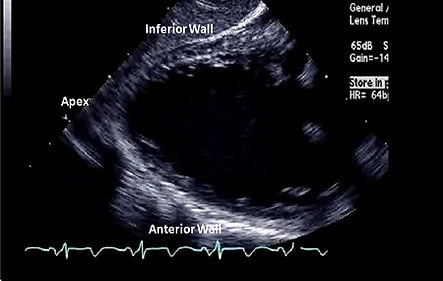Transgastric Long Axis
For any given view obtained in the short axis, a similar long axis projection can generally be obtained by omniplane scanning 90 degrees from the corresponding short axis plane or using the biplane technique.\
Transgastric Long Axis, 90 Degrees: Left Ventricle



By omniplane scanning to 90 degrees, one can see the anterior and inferior wall of the left
ventricle as well as the LV apex to evaluate for left ventricular thrombus.
Transgastric Long Axis, 90 Degrees: Mitral Valve

At 90 degrees, withdrawing the probe gently allows visualization of the mitral valve leaflets, left atrium, left atrial appendage and subvalvular apparatus. This is an excellent view for evaluating mitral valve vegetations including chordal/papillary muscle involvement and for visualizing ruptured chords.
Transgastric Long Axis, 90 Degrees: RV Long Axis
By carefully rotating the probe clockwise from the transgastric long axis view of the LV at 90 degrees, a long axis view of the RV can be obtained. This is another excellent view to assess RV function and to view the anterior wall of the RV.
Transgastric Long Axis, 110-130 Degrees: LVOT and Aortic Valve

By increasing the scanning angle to roughly 100-130 degrees, the left ventricular outflow tract and aortic valve can be visualized. This view is similar to an inverted parasternal long axis view. It can be used to assess Aortic valve and LVOT gradients.

From this view, one can Doppler across the aortic valve to assess degree of aortic stenosis and regurgitation, particularly if a deep transgastric view is technically limited.